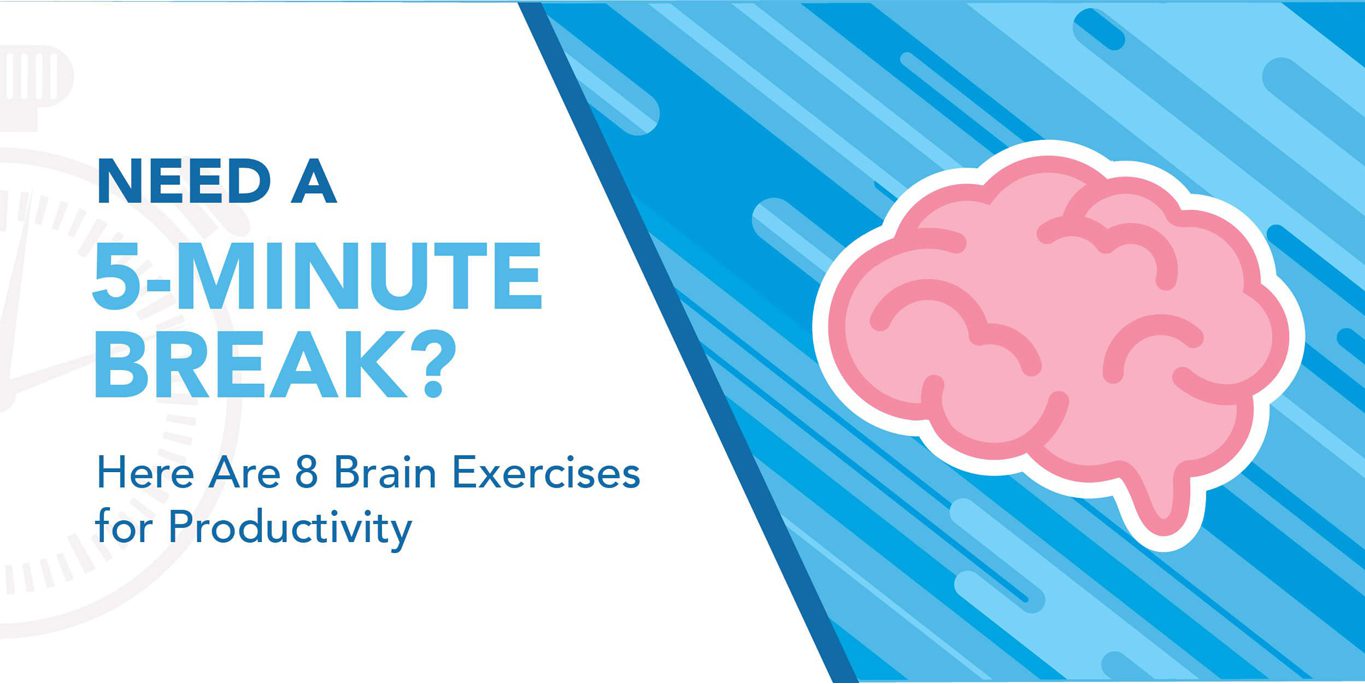Need a 5-Minute Break? Here Are 8 Brain Exercises for Productivity

“Exercise? How can I benefit from a 5-minute break if I have to exercise?” is probably what you’re thinking right now. Allow us to explain.
You’ve heard of sudoku, memory games, meditation and its fair share of benefits, among other techniques. Did you know these are perfect examples of constructive brain exercises that you can do, even with just five minutes to spare? Because they are!
The next question you might ask is, “What classifies these activities as such?” To best answer this question, let’s first define what “brain exercise” means and why it’s so important.
So, what exactly are brain exercises?

Simply put, brain exercises, or brain training, can be defined as “learning ways to increase your intelligence, memory, ability to think, etc.” Exercising or training your brain “refers to the structured use of cognitive exercises or techniques. Its aim is to improve specific brain functions.”
As comfortable as routines can be, it’s also essential to break from them because they “provide the brain with very little stimulation. Just as your body gets soft and lethargic from lack of physical activity, your brain gets sluggish and slow from too much routine.”
Exercising your brain doesn’t need to be complex; you can stimulate your brain with something as simple as listening to music or reading out loud. The key is to use as many of your senses as possible. In fact, it’s already a challenge to do anything with your eyes closed because of how much we rely on vision. So what are other techniques can you do to train your brain?
Brain exercises to boost productivity
There are many various ways you can train your brain, but there are a couple of things you should keep in mind: consistency and variety. The human brain is so efficient that when it learns how to do something, it stores that knowledge so the next time you have to do it, it’s less complex.
Here are some ways you can exercise your brain in as short as five minutes. Remember to mix and match and intensify to keep it challenging!

Switch things around.
Studies show that using your dominant hand activates one hemisphere of your brain. Using your non-dominant hand activates both hemispheres, opening “new” ways of thinking.
Use your non-dominant hand to write notes, move your mouse, brush your teeth, or eat a snack. Turn your watch the other way around and read time upside down. It may take some getting used to and others might think you’re a bit kooky, but give it a go.
Count without hands.
Without a pen or paper, either! No need to show your solutions — try to solve mathematical problems off the top of your head.
Dr. Rick Nauert shares, “Memory-based math problems stimulate a region of the brain called the dorsolateral prefrontal cortex, which has already been linked to depression and anxiety. Studies have found, for example, that higher activity in this area is associated with fewer symptoms of anxiety and depression.”
You can start small by counting spare change; you might be surprised when you start calculating everything mentally!
Build a new social connection.
Getting to know an unfamiliar face, having to recall a name — these are always stimulating to our brains! Meet someone new across the room, whether you’re at a café or at the office. It can even be someone from someplace you’ve never been. Make a pen pal through the powers of the internet! You might just bridge a gap that you never noticed before.
Shake things up.
If you work at a traditional office setting, ask to trade or switch seats with a coworker and get a change in perspective. If you’re working from home, step out of those four walls and set up your tools at a different space, like the coffee shop at the corner or at a coworking space. And on the way home, take a different route than you’re used to — but make sure to stay safe!

Make a move.
Literally — take a turn around the room. Pace when you hit a roadblock, particularly for a hard task or project. Seeing things at a different angle might give you that Eureka moment you’ve been waiting for. You can even just stretch in and out of your seat! Do a few desk exercises to get the blood flowing. The best option: get in the habit of working out to stay physically active. It does wonders for your brain!
Learn something new.
Similar to making new connections, your brain loves learning new things. Take steps to pursue a passion project. Open Duolingo for a change and advance at a skill. Head over to online course websites like Coursera, Udemy, or TED Ed to brush up on some old skills or learn brand new ones. If a topic interests you and helps you out at work, that’s the one you should take!
Play with touch.
Fidget with small objects. Play “10 things”. Grab a Rubik’s cube and try your best to solve it as fast as you can. Take a used piece of paper and fold origami pieces. These mini-movements help us focus better and relieve stress levels. Clinical Neurosciences Researcher Harriet Dempsey-Jones says “Fidgeting could provide physiological stimulation to bring our attention and energy to a level that allows our minds to better focus on the task at hand.”
Cultivate your creative side.
Being creative allows us to express thoughts that might be difficult or impossible to articulate otherwise. Write a haiku. Draw an experience. Express your emotions through color.
Whether you’re a linear or a non-linear thinker, it’s important to have a creative avenue. According to this article on the importance of a creative outlet, “Your form of expression can provide a break from the stress and anxiety of life, transform some confusing or depressing thoughts into a positive product, or help you create something tangible and memorable from your positive thoughts.”
Why you should make brain exercises a habit

We applaud your dedication to work. Still, there’s nothing wrong with taking time to take care of yourself. The first thing that might pop into your head when thinking of health and self-care is exercise. And while we’re not discounting the healthy benefits of what an actual workout can do for you — physically, mentally, and emotionally — those usually take longer than five minutes.
Taking short breaks is just as important as having a productive workday. Putting off a task can help prevent stress and burnout. And if you need a bit of structure in scheduling your breaks, try practicing the Pomodoro technique where you work for 25 minutes and pause for five.
There’s no one way to exercise your brain, and that’s a good thing! Remember: these exercises have to vary and you have to change them up consistently. You’re free to explore and find the most effective ways to ignite your productivity. So if you’re just starting out, feel free to try out what’s on our list!